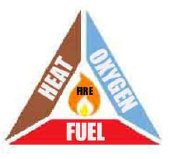Dry Powder Fire Extinguishers















ADVANTAGES AND DISADVANTAGES OF DRY POWDER FIRE EXTINGUISHERS
To help customers make informed judgments about the selection
of the best extinguishing media for specific operational circumstances, an understanding of the advantages and disadvantages of each
is essential. In respect of dry powder fire extinguishers
ADVANTAGES
ü Quick
Knockdown - Dry powder, when correctly applied and at the required application rate, has the ability to ensure an initial quick knockdown
of the fire.
ü Non-Conductor of Electricity - Dry powder can safely be used at incidents where
it is known or suspected that ‘live’ electrical equipment is present.
ü Good on Running Fuel Fires
- Owing to its fire extinguishing action, dry powder, when used in conjunction with foam sprays, can be extremely effective when used
on running fuel fires.
ü Creates No Thermal Shock - Because the application of dry powder onto
hot metal does not cause thermal shock, it is particularly useful for dealing with fires involving undercarriage assemblies.
ü Good Heat Shield - The discharge of dry powder creates an effective shield against radiated heat. In cases where large quantities
of powder are discharged, this has the potential to shield surrounding structures and personnel from the damaging effects of the fire.
ü Wide Range Of Use – Dry powder extinguishers can be used on class A,B and C Fires.
ü Wide Temperature Range – Typically can be used between -20oc to +60oc.
ü Mass for mass the most
effective fire-fighting medium.
DISADVANTAGES
X Visibility Problems - The application of dry powder and generation of a dense powder cloud will dramatically reduce the visibility
of the operator so they may not be able to use vision to judge the effectiveness of the powder on the fire or may jeopardise escape
in a fire.
X Can
Cause Breathing Problems - If dry powder is inhaled it can irritate the respiratory organs. Whilst short term exposure is not considered
to be harmful, repeated inhalation should be avoided.
X Leaves a Residue - Dry powder is a very messy extinguishing agent that will leave behind a residue that is corrosive to certain materials and because it is a find powder it can also be abrasive. Thoughtless use may lead to the powder causing more damage than the fire itself, using dry powder fire extinguishers in kitchens or offices as powder can contaminate food and inhibit the use of electrical components such as keyboards if discharged. Because of the properties of powder being very light and easily carried through the atmosphere dry powder extinguishers when discharged risk contamination over a wide area.
X Poor
Post Fire Security - Due to the smothering and chemical interference effect of dry powder, it will only remain effective whilst it
is present in the atmosphere above the fuel. Because it is a cloud of fine powder, particles of it can easily be dispersed by
the wind, giving a very real danger of rapid re-ignition of fuel.
X Vulnerable To Packing Down – Failure of extinguisher can result from the packing down of the powder within the extinguisher body, this problem is associated more with cartridge operated extinguishers. This can be a particular problem on vehicle mounted equipment as the vehicle vibration will cause the powder to compress under its own weight. Regular maintenance routines are essential; to prevent failure of equipment at a crucial time.
X Can
Break Down Foam Blanket – The use of dry powder close to an area covered by a foam blanket may lead to the foam breaking down more
quickly.
X Usage & Location – Because of the disadvantages above dry powder extinguishers should only be found in industrial settings and where no alternative fire extinguisher mediums are suitable. They should not be found in offices, flats etc.
X Limit of use, not to be used on class D,F fires










How Does Dry Powder Extinguish The Fire












